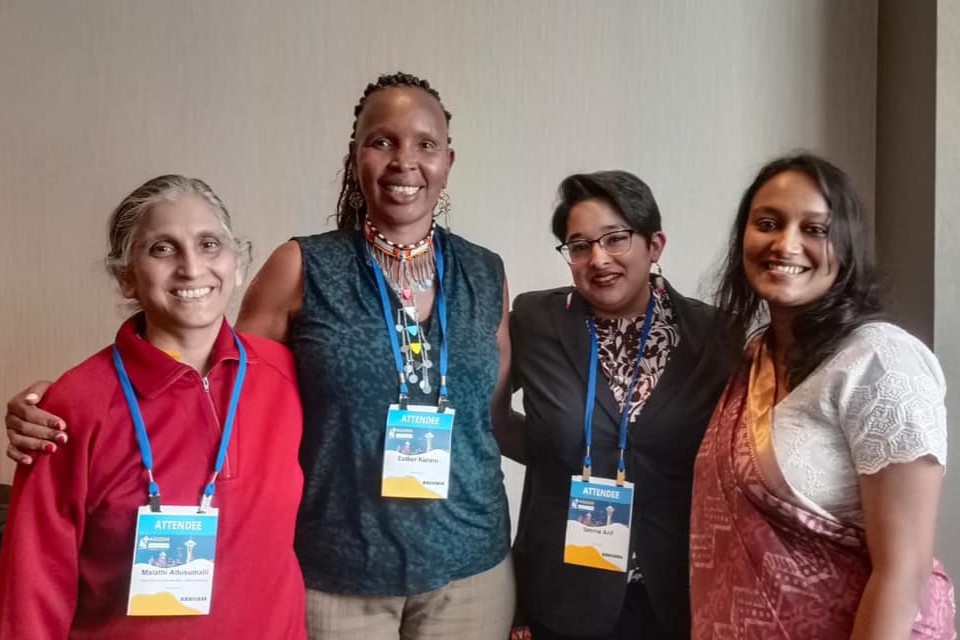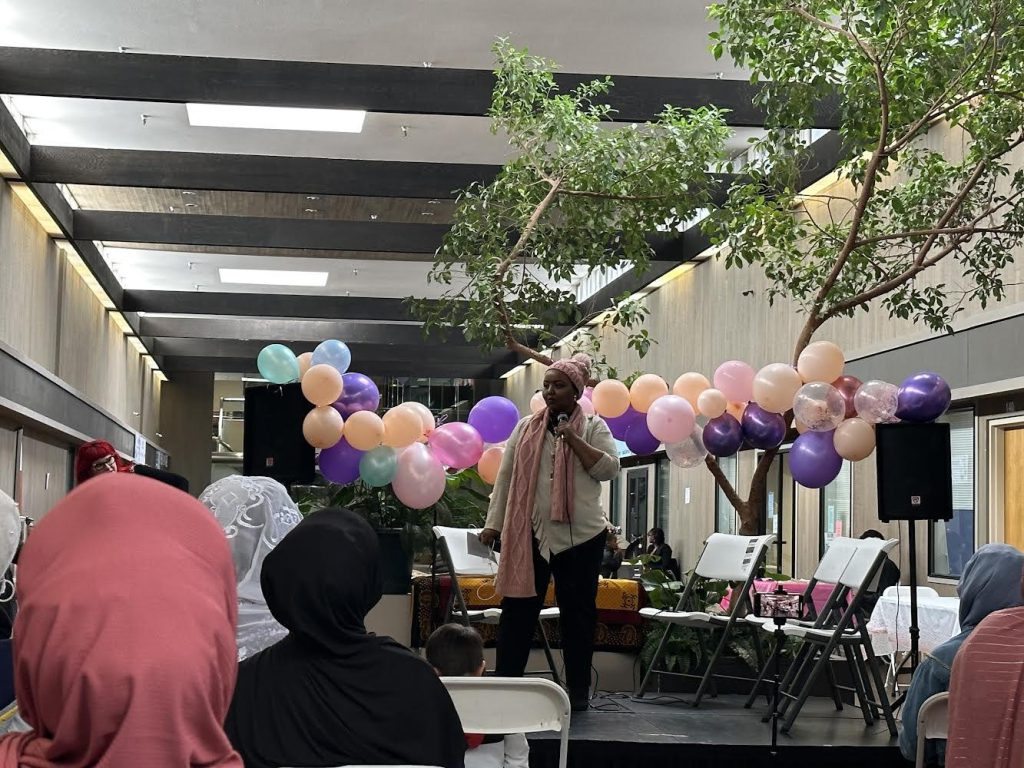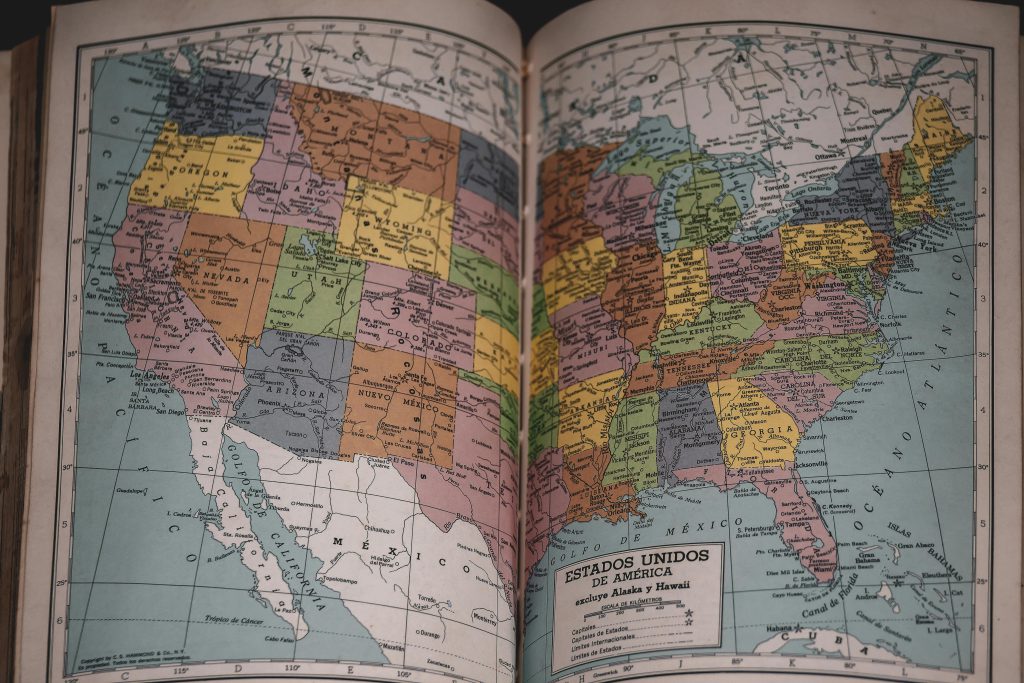Bringing female genital cutting to the forefront: How Sahiyo helped Nevin Sutherland attend the 2024 Asian Studies Conference

This past March, Sahiyo had the honor of supporting Nevin Sutherland in attending the Association for Asian Studies 2024 Annual Conference. This annual conference focuses on facilitating conversations about and around Asian cultures. Nevin, a current PhD student at Delhi University, sought to highlight the issue of female genital cutting (FGC) in the hopes of sparking a larger discussion about how the practice is ongoing in many parts of Asia. “As the daughter of a single mother and a PhD student, there’s no way I would have been able to attend the conference and put together the panel without Sahiyo’s help,” Nevin said. “They gave me connections to the other panelists, and they also gave me a travel scholarship. This support allowed me to attend my first international conference and gave me more confidence in the work that I am doing.” With Sahiyo’s support, Nevin assembled a panel of fellow Sahiyo volunteers and contacts to facilitate the discussion: Huda Syyed, Umme Kulsoom Arif, Esther Kenesoi, along with Nevin herself. Their goal was to educate the audience about the complexities and nuances of FGM/C in Asia, discuss how FGM/C in Africa often receives more worldwide attention, and explore the underlying gender and sexual politics that keep the practice alive in so many communities. “Our panel was under the category of South Asian studies. We were placing FGM in the context of South Asia and comparing it with the practice in Africa. We wanted to look at how even now most of the FGM/C discourse is largely focused within Africa. We compared what the different dynamics are in African and Asian communities and how the practice affects Asian communities differently.” The panel succeeded in sparking a conversation and engaging with the attendees, who asked a number of questions about FGM/C. “After the initial panel discussion, the participants began a conversation about other forms of gender-based violence and how sexual politics precipitates GBV,” Nevin said. “We found that we all had something in common; We all had faced different forms of violence against women, especially in the context of human sexuality, in one way or another. We were able to find a degree of understanding in each other, even those who were not survivors were able to see on some level how FGM/C was a harmful violation of a woman’s body.” That realization, in and of itself, was healing for many. “The most fulfilling part of the whole discussion for me was at the end. One of the participants asked if we could have a group hug,” Nevin said. “It had been a pretty intense and emotional conversation, so everyone was feeling a lot. Everyone came together and we had this beautiful big hug, and there were a lot of tears. It was such a healing moment. It reminded me that the work to end the practice is really important, but the healing from it is equally as important.” Sahiyo is thrilled to have helped Nevin bring this vital information to the Association for Asian Studies 2024 Annual Conference and we hope to continue supporting activists, academics, and all those who are fighting to end FGM/C.
The Washington Coalition to End FGM/C Interview Series: Dr. Muna Osman

Recently, policy interns at Sahiyo have been interviewing members of the Washington Coalition to End FGM/C to learn more about coalition members’ important work toward policy creation on female genital cutting (FGC). Sahiyo’s policy intern, Sara Khattak, talked to coalition member Dr. Muna Osman, DNP FNP-BC, a prominent advocate in the work to end FGC in Washington state and a respected nurse. Muna has been a leading voice in the Washington movement for over 10 years. Growing up, Dr. Muna Osman was exposed to female genital cutting (FGC) and always opposed the practice, even though she didn’t fully understand it at the time. It wasn’t until she was in graduate school that she decided to make FGC the focus of her studies. “I came from a country that practices. I was in the Middle East, and it happened to me.” As she delved deeper into the issue, Dr. Osman found that doctors in the US often didn’t know how to address FGC or support survivors. This motivated her to develop a curriculum to educate clinicians beyond obstetrics and gynecology (OB/GYN) professionals about the negative short- and long-term impacts of the practice. Gaining the trust of her own community was one of Dr. Osman’s biggest challenges. “At the beginning, there was no community, because the people I’m teaching – even my professors in the graduate school – were like, who cares? It’s a foreign [practice],” she recalled. Over time, Muna found that slowly integrating conversations about FGC into her work with the community-founded safe motherhood program, Mama Aman, helped build that trust. “I started with pregnancy. But after I graduated, we worked with Mother Africa at the community level. People know that I’m volunteering. I don’t work for nobody. I don’t intend to make money off them, so they start listening to me.” Dr. Osman believes that truly making progress requires bridging the generational divide within immigrant communities. “We need to bridge the gap instead of making it bigger and give the respect they deserve, [even if] you’re a kid. You have the knowledge that we didn’t have. Like the parents. Most of the parents came to start a new life. We came to start a new life for our kids. We didn’t come here to become evil again.” Her approach involves empowering youth to assert their bodily autonomy, while also working to educate and engage adults in a respectful way. “We need to empower the kids and tell them, ‘say no.’ I don’t care who you talk to, your teacher, but the teacher needs to know. It’s a cultural practice.” Dr. Osman’s vision for the future includes establishing a comprehensive resource center to support survivors and communities affected by FGC. This center would involve crisis hotlines, therapists trained in cultural humility, and outreach workers embedded within different ethnic communities. “I had a vision that we will have a resource with all this money. To provide the education we need. We go to the communities and we always ask them ‘how much do you know about FGC?” By building a holistic, community-driven approach, Dr. Osman believes we can make real progress in ending FGC in the United States. As she put it, “we cannot say that a one-person approach fits all: We want to be culturally appropriate.” (Dr. Osman shaking hands with Governor Jay Inslee of Washington state after the signing of the Bill on FGC.) Those interested in getting involved can reach out to Dr. Osman directly or connect with the Washington Coalition and other organizations working on this critical issue. We extend our gratitude to Dr. Muna Osman for her invaluable contributions and insights. To learn more about our ongoing work and other interviews, visit Sahiyo’s website.
The forgotten history of female genital cutting in the United States

By: Sara Khattak Female genital cutting (FGC) is a practice involving the partial or total removal of external female genitalia or other injury to female genital organs for non-medical reasons. While FGC is a form of gender-based violence that is often mistakenly understood to only occur in certain cultural traditions in Africa and the Middle East, the occurrence of FGC has a history in the U.S. that is less widely known. Understanding the history of FGC in the U.S. is crucial for recognizing the global nature and impact of FGC, and for understanding how to address and end the harmful practice. In the late 19th and early 20th centuries, FGC was practiced in the U.S. and U.K. primarily by medical professionals. Despite the lack of scientific evidence supporting its effectiveness, FGC was often carried out as a medical treatment for various perceived medical and psychological conditions, including hysteria, “lesbianism,” and excessive masturbation. Another practice that should be considered a form of FGC is the “husband stitch.” The “husband stitch” refers to the practice of adding an extra stitch during the repair of a perineal tear or episiotomy after childbirth, ostensibly to tighten the vaginal opening for increased male sexual pleasure. Just this year, a lawsuit was filed in California against an OB-GYN who for decades allegedly performed FGC on patients. These practices were influenced by prevailing attitudes toward women’s sexuality and health of the time period, which included misconceptions about the female anatomy, a tendency to pathologize women’s sexual desires, and a patriarchal medical system that often prioritized male sexual pleasure and control over women’s bodily autonomy and well-being. Clitoridectomies fell out of popularity in the United States in the mid 1900’s, and by 1977 were no longer covered by insurance. At the federal level, however, FGC wasn’t prohibited until 1996. With the passage of a federal law it became illegal to perform FGC on a girl under the age of 18, or for the parent, caretaker, or guardian of a girl under the age of 18 to facilitate or consent to FGC being performed on her. Transporting a girl for the purpose of FGC became a punishable offense in the U.S. in 2013. Even after FGC stopped being a legally recognized medical practice, and Congress passed a federal law making it illegal to perform, there were still reports of FGC being performed by health professionals in secrecy. In fact, in 2018, a medical doctor in Michigan was charged with performing FGC on minor girls who had traveled to Michigan from other states to undergo the practice. It was then reported that Dr. Jumana Nagarwala was a part of a secret network of medical providers who performed FGC on hundreds of girls in the U.S. The case triggered significant legal and ethical discussions in the media, amongst anti-FGC advocates, and legislators, not only about FGC, but also about children’s rights and medical ethics. It was also reported that FGC was occurring in some white fundamentalist Christian communities. The persistence of FGC in these communities underscored the need for a broader societal reckoning with how cultural and religious beliefs intersect with human rights, even within demographics not typically associated with this issue. However, disappointment arose when the 2018 case was eventually dismissed on a technicality, relating to how the original law banning the practice was passed by Congress. This set back highlights the challenges in addressing FGC within the current legal frameworks. As a response, Congress passed the Strengthening the Opposition to Female Genital Mutilation Act of 2020, also known as the Stop FGM Act 2020, to ensure that FGC remained illegal to perform on a girl in the United States. Laws on FGC also vary at the state level. In Connecticut, for example, there are currently no state-level anti-FGC laws. The CT Coalition to End FGM/C, a survivor-led organization, has been working since 2020, advocating for the passage of laws that protect children from FGC and support survivors. Today, various efforts are being made to end FGC in the U.S. through education, advocacy, and community outreach programs. Educational initiatives aimed at informing healthcare providers, educators, and the general public about the harms of FGC and the legal implications of participating in or condoning the practice are being carried out by community-based organizations across the country. In the last 3 years, the Department of Justice, Office of Victims of Crime, funded several programs aimed at preventing and responding to FGC, including grants for community-based organizations and law enforcement training initiatives on the practice. Despite these efforts, significant challenges remain. One of the primary obstacles is the enforcement of the laws against FGC, as it can be difficult to detect or prove cases of the practice occurring. Additionally, there is resistance to ending the practice in some communities where FGC is seen as a social norm that must be done in the name of tradition, as a rite of passage, or due to it being an identity marker. Changing these deeply entrenched social norms requires sustained and sensitive engagement with community leaders and members from impacted communities. Survivors of FGC play a crucial role in the movement to end the practice. By sharing their stories, survivors help to humanize the issue and bring attention to the physical and psychological trauma caused by FGC. Their voices are powerful tools for advocacy and education, helping to shift public perception of the practice and inspire action against it. A large part of Sahiyo’s mission is working with survivors to share their stories and experiences, to inform communities, governments, and the public about the harms of FGC. These stories are critical in helping to enforce and create laws that address FGC because those who have gone through the practice have the most knowledge and understanding of why and how it should be prevented. If you want to learn more about Sahiyo’s work with survivors, listen to survivor stories here.
